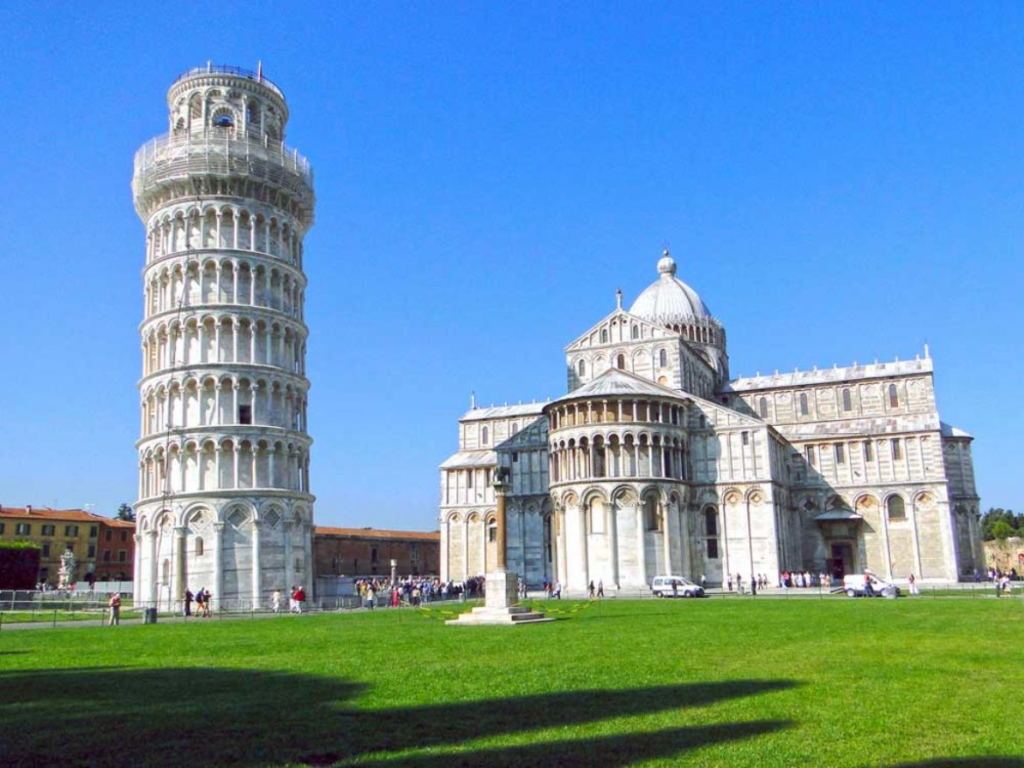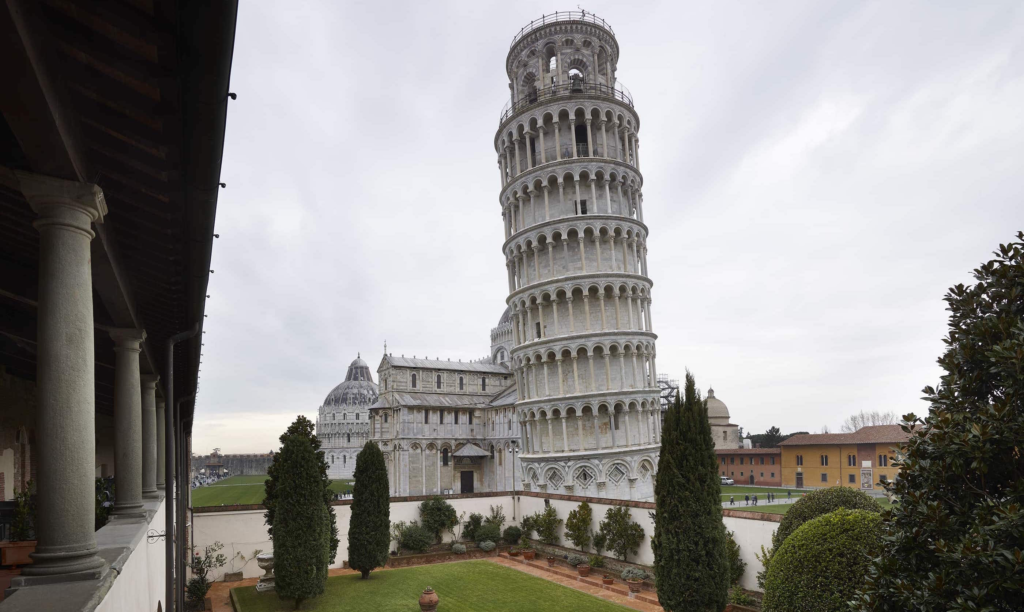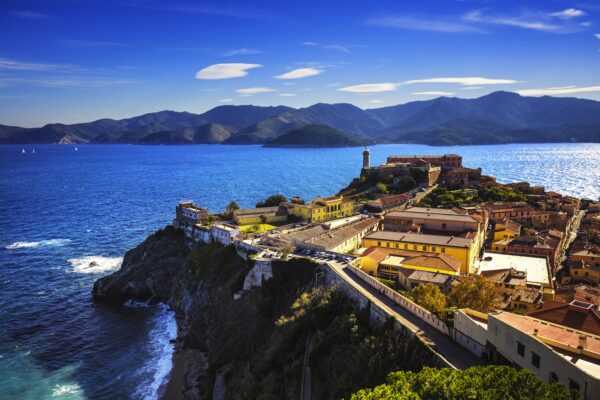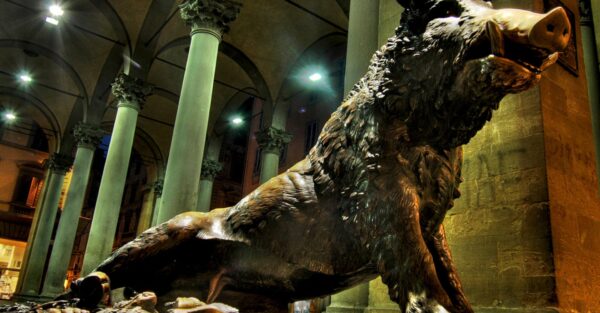Known all over the world also as the Leaning Tower, the Tower of Pisa is not only the symbol par excellence of the Tuscan city that welcomes it, but also one of the most beloved and iconic monuments of Italy.
Built between the twelfth and fourteenth centuries, it is located in the beautiful Piazza dei Miracoli and consists of the bell tower of the Cathedral of Santa Maria Assunta; in fact, over time, had the task of marking time (both human and divine) thanks to its seven bells, as many as musical notes and each with its own name.
Even today, the Tower of Pisa is a tourist attraction and always manages to enchant visitors both for its architectural beauty, both for its original slope that, defying any law of statics, continues to keep it perfectly stable. And that’s exactly why she’s been nominated to be one of the seven wonders of the modern world.

The history of the Tower of Pisa
The construction of the tower began in 1173, but the authorship is still unknown: in some cases it is attributed to the architect Diotisalvi who, in the same period, was responsible for the construction of the baptistery. The two buildings actually look very similar. Other scholars, however, believe that the realization is to be attributed to Gherardi, while Vasari believes that the project is by Bonanno Pisano. This last thesis is supported by the discovery of an epigraphic fragment engraved “citizen of Pisa named Bonanno”, but probably the cast belonged to the door of the Cathedral.
In short, you do not know the name of the real father of the Tower of Pisa but, in any case, you can see that he did a great job (whoever he is)!
Why is the Leaning Tower of Pisa?
Regardless of the architect’s name, one thing is certain: the first phase of construction was interrupted in the middle of the third ring due to a subsidence of the ground, in turn caused by the ancient presence of a bend of the river Auser.
The instability of the terrain has long hindered the continuation of the work that, in fact, resumed in 1275 thanks to Giovanni di Simone and Giovanni Pisano with the addition of three floors to the three original rings that, bending in the opposite direction to the slope, they had as objective just the straightening of the tower.
From that moment on, in reality, the overhang increased but there were also periods of reduction of the slope. During the restoration works carried out in the nineteenth century, then, it was finally dispelled the myth that the tower was thought from the start as leaning: the excessive presence of underground water found, In fact, it confirmed the true cause of the land’s compliance, certainly not planned.
A further reduction in the slope occurred during the consolidation works carried out between 1990 and 2001, during which the basis was also consolidated to ensure the safety of visitors and allow them to enter the building peacefully.

Structure and bells of the Tower of Pisa
The Tower of Pisa contains two rooms inside: the Fish room, at the base, which takes its name from the presence of a bas-relief depicting a fish and the bell cell, located at the seventh ring.
In addition, there are three flights of stairs: the first leads continuously from the base to the sixth ring, the second door from the sixth to the seventh ring and the third, smaller, connects the seventh ring to the top of the tower.
Once you reach the top you can get to know the seven bells of the Tower of Pisa, each with a different name and history:
- Assunta, the greatest;
- Crucifix;
- San Ranieri;
- Dal Pozzo, which suffered serious damage during the Second World War;
- Pasquereccia;
- Third;
- Vespruccio.
The bells still ring before the mass inside the Duomo and every day at noon.
Curiosities about the Tower of Pisa
Being a very ancient building and inevitably linked to the history and the famous people who were born or passed by the city, around the Tower of Pisa there are many interesting anecdotes. Here are the main ones:
- According to an ancient legend, the scientist Galileo Galilei threw two weights right from the top of the tower to prove the fall of the grave bodies;
- The bell Saint Rainier was initially called Justice or Bell of the Traitor because, according to ancient customs, it sounded whenever a traitor was sentenced to death. It is said, in fact, that he also played on the occasion of the condemnation of Count Ugolino;
- In the past, each bell was associated with a certain moment of the liturgical day: the Third sounded at the third hour of the day, then at nine in the morning; Vespruccio at vespers, then at six in the afternoon; Pesquereccia, instead, announced Easter;
- The Tower of Pisa can be called a movie star, since there were really many films shot in the area: among the most famous “Amici miei atto II” by Mario Monicelli, “Totò al Giro d’Italia” by Mario Mattoli and “Padre Padrone” by the Taviani brothers. Recently, then, one of the two protagonists of “The brilliant friend”, Lenù, walks several times through Piazza dei Miracoli with her boyfriend;
- The tower is tinged with different colors according to the lights of the day and on special occasions: blue for the anniversary of the UN or pink for the World Day against breast cancer.
Moreover, the Tower of Pisa is certainly not the only leaning tower in the world, but there are others:
- la Pagoda della Collina della Tigre, in Cina;
- la Torre del Monastero di Kilmacduagh, in Irlanda;
- la Torre pendente di Nevyansk, in Russia;
- la Torre di Suurhusen, in Germania;
- la Torre di Oldehove, in Olanda;
- la Torre di Torun in Polonia
In Italy, the Basilica of San Pietro di Castello in Venice also boasts a leaning bell tower and, in the same city of Pisa, also the bell tower of San Nicola and the bell tower of San Michele degli Scalzi turn out to be inclined, always because of the sandy and clay soil that characterizes the entire area.

The numbers of the Tower of Pisa
The most curious will certainly want to know some “technical” details of the Tower of Pisa, which can be easily expressed in numbers:
- height: 58.36 meters;
- external diameter: 15 meters;
- weight: 14,453 tons;
- inclination: (current) about 5,5 hectares;
- stone blocks: 29,424;
- stone surfaces: 7,735 square meters;
- capitals: 207;
- stairs: 273 steps.
A great spoiler for those who want to visit it soon!
How to visit the Tower of Pisa
It is possible to visit the Tower of Pisa at any time of the year, but the advice is to buy/ book tickets before arrival to avoid long queues and be sure to visit it on the scheduled day.
You can choose to visit both the tower and the baptistery with the purchase of a single ticket for 20 euros, or choose the complete visit of all the monuments and museums of Piazza dei Miracoli with a ticket from 27 euros.
Although there are no reduced tickets, admission is free for disabled visitors and their companion. For safety reasons, children under the age of 8 are not allowed, while children under the age of 18 must be accompanied by an adult.
The tour of the tower is about 30 minutes and, considering that you have to go up/ down 251 steps, is not recommended for people suffering from motor and cardiovascular diseases. In addition, the floor is rather bumpy and slippery, so it is preferable to wear very comfortable clothing and footwear.
For more information please visit: https:///www.opapisa.it/visita/torre-pendente.
Copertina: tuscanypeople




